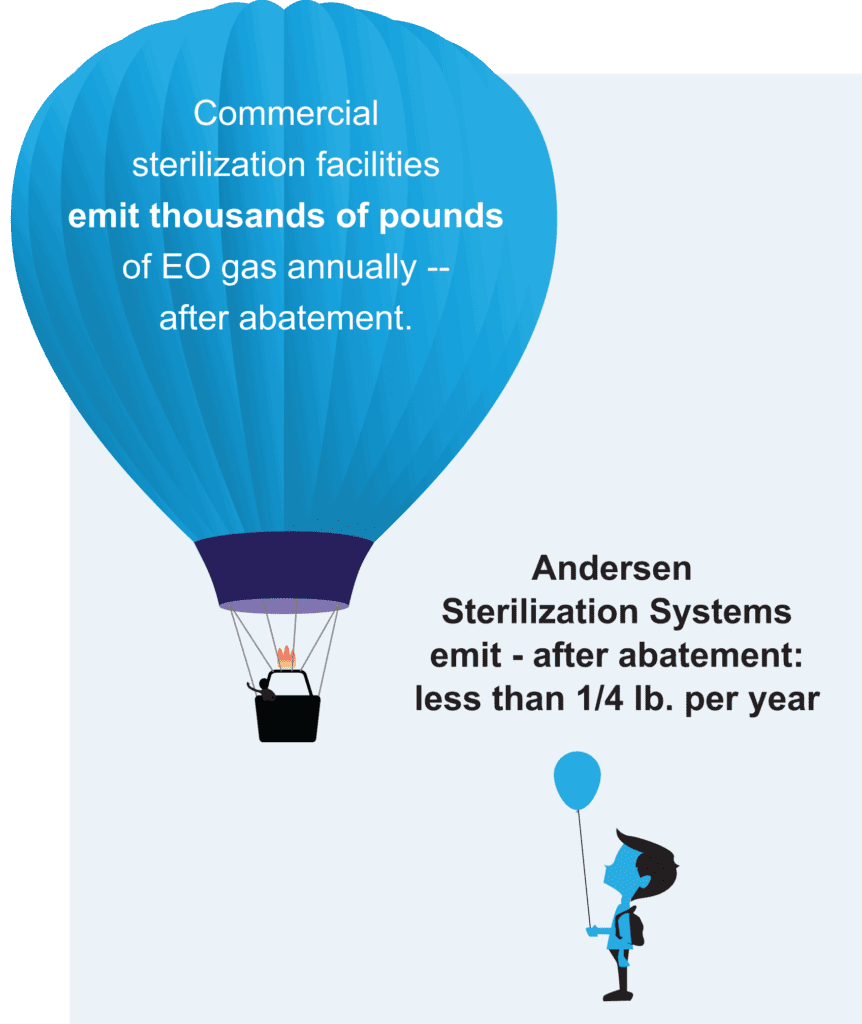Andersen Sterilizers’ Response to Proposed EPA Guidelines to Reduce EO Emissions
The issue
On April 13, the U.S. Environmental Protection Agency (EPA) published a risk assessment of ethylene oxide (EO or EtO) and proposed regulatory requirements that, if approved as written, would severely restrict the use of EO sterilization in all facilities. The comment period expired on June 27.
As you know, Andersen sterilizers use EO as sterilant. We wanted to reach out to our customers proactively to let you know our position and explain how this may impact you.
Please note: These are proposed regulations. A final decision on these proposals is expected in March 2024, after which there will be an 18-month phase-in period for whichever of these proposals make it into law.
Proposals that may affect you
- Under the proposed EPA regulations, health care facilities (HCF) – including veterinarians and single practitioners like dentists and plastic surgeons – would no longer be exempt from burdensome EPA EO regulations.
- The document proposes several engineering changes to HCF buildings, such as a dedicated room for sterilization with negative pressure air-flow and abatement equipment. (p. 54)
- While the document is ambiguously worded, it seems the EPA may intend to limit HCF workplace exposure levels to 10 ppb (p.12, 79). This level is so low, that it is less than the exposure many individuals have in the natural world, from plant decay and made inside their own body for example, and would be unrealistic for businesses to comply with.
- The regulations ask about the feasibility of requiring HCF employees who operate sterilization equipment to wear “Self-Contained Breathing Apparatus (SCBA) or supplied airline respirators” (p. 55) to reduce their exposure risk. The question implies an intention to require this PPE of HCF staff.
More details about the specific proposals that may affect your business and our response to them can be found on the Deeper Dive page.
Not written for you
The proposed regulations are written to regulate a different industry — commercial sterilization facilities that have chambers large enough to drive a forklift into. These facilities can emit thousands of pounds of EO into the surrounding environment per year (in some instances, over three tons).
However, in drafting these new rules, the EPA does not differentiate between a commercial sterilization facility and the sterilizers we create — and you operate — that use just a small amount of EO per cycle, 17.6 grams or less. This is 90% less than any other “all in one” (p.18) sterilizer on the market and thousands of pounds less than the commercial sterilization facilities.
As you may know, EO has been thoroughly evaluated and re-evaluated by scientists and regulatory bodies worldwide for over 70 years and was first approved for use by the U.S. government in 1950, and by the EPA in 1971 ― shortly after the agency was formed. In making its recommendations, the EPA disregarded this and other scientific and peer-reviewed data, including an assessment from the Texas Commission on Environmental Quality (TCEQ).

Our Position
Andersen Sterilizers actively joined the efforts of the Ethylene Oxide Sterilization Association (EOSA), the Advanced Medical Technology Association (AdvaMed), and several other industry organizations in encouraging the EPA to consider all available and relevant peer-reviewed data as they make vital decisions to protect public health and worker safety ― while not disrupting medical device availability and negatively impacting patient care and safety.
We believe imposing draconian regulations on the health care providers, veterinarians and research facilities that use our sterilizers would needlessly negatively impact businesses like yours as well as the health and safety of patients.
We submitted comments to the EPA during the comment period and had a conversation with EPA decision-makers the day the comment period ended — with the door open for continuing conversation.
Draft regulations like this often undergo considerable change before being enacted and occasionally never go on the books at all. We feel that there is a good chance that the final version of these regulations will not apply to Andersen’s customers.
Regardless, we will keep you updated via these pages and social media.
DID YOU SUBMIT A COMMENT TO THE EPA?
Thank you! We are so thankful for all our customers who took the time to reach out to the EPA and let them know how this draft regulation would impact them.
Next steps

iris = bad science
The EPA’s risk assessment tool – IRIS – is deeply flawed & controversial



